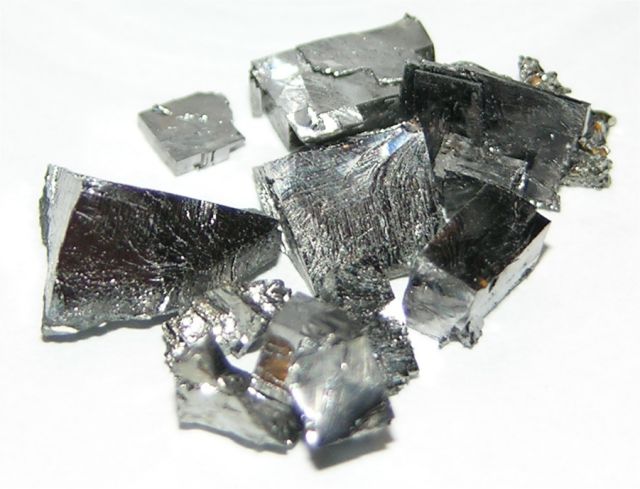Tantalum

Tantalum
Tantalum - overview
Tantalum is a rare, highly corrosion resistant metal of the refractory metals group (which also includes, tungsten, molybdenum, niobium, zirconium, titanium, chromium, osmium, vanadium and rhenium). Tantalum always occurs together with niobium, with which it chemically similar.
Tantalum was discovered in 1802 by Anders Ekeberg and after much initial confusion with niobium, was finally demonstrated unequivocally to be a separate element in the 1860's. [1] It is found in the minerals tantalite, columbite, wodginite, euxenite, polycrase and microlite. Tantalum was once known as tantalium [1] [4]
One of Tantalum's most renowned qualities is that it is highly immune to aqua regia - which dissolves many other metals. Tantalum also has an extremely high melting point (3017ºC) and this is only exceeded by tungsten, rhenium and carbon. [1] Tantalum is highly unreactive below 150ºC, however, it becomes more reactive at high temperatures. It can be drawn into wires with high tensile strength and a filament made of tantalum can be used to evaporate aluminium. [7]
Tantalum Resources and Production
Tantalum occurs in a number of minerals, for example tantalite, microlite, samarskite, wodginite, euxenite, polycrase and fergusonite. The primary source of tantalum is Australia. [1] Other major sources include Brazil, Rwanda, Congo and Canada. [5] Smuggling of tantalum ore has been connected with the terrible military conflict in Rwanda and the Congo. [1] There are many other potential sources of tantalum currently being explored.
Tantalum is produced from ore in a multi-stage process. In the case of tantalite / columbite, first the mineral is crushed and gravity separation is used to separate the two minerals. The minerals are treated with acids and then processed with solvents. Finally tantalum is produced from fluorides by the reducing action of molten sodium. [1]
Tantalum Uses
Tantalum has a wide variety of industrial uses but the most significant is in electronics for tantalum capacitors. These accounted for over 60% of tantalum use in 2008. Major uses of tantalum capacitors are portable computers and mobile phones. [5] Because of the chemical properties of tantalum, the capacitors can be made smaller than aluminium capacitors - and so they are the primary choice for portable devices. Tantalum is also used in some high-power resistors and other electronic components such as radio tubes, now not widely used. [1]
Tantalum is an essential component of the dielectric resonators in 2.2 gigahertz cell phone base stations.
Some tantalum compounds exhibit extreme hardness. Tantalum carbide is a very hard material that is used in cutting tools and has the extremely high melting point of 3880ºC. Only diamond is harder. [4] Tantalum is included in some superalloys for jet engines and missile components.
Due to its corrosion resistance, tantalum is ideal for use in some applications for handling corrosive liquids such as hydrochloric acid. [1]
Tantalum is also used in special glass for camera lenses, and in some high-end watches. [1]
Tantalum is highly biocompatible - meaning that it has been used in body implants. It is also used in surgical instruments, for the same reason, together with its resistance to corrosion.[1]
Other materials can be used as substitutes (though inferior) for tantalum in many of its major applications. [5]
Tantalum Facts
| Name | Tantalum |
| Symbol | Ta |
| Atomic Number | 73 |
| Melting point (Celsius) | 3017ºC |
| Density | 16.65 g/cc |
| Hardness (Moh) | 6.5 |
| Resistivity (nanoOhms / meter at 20ºCelsius) | 131 |
Tantalum References:
[1] http://en.wikipedia.org/wiki/Tantalum
[2] http://www.springerlink.com/content/528370705p830m56/
[3] http://en.wikipedia.org/wiki/Tantalum_carbide
[4] http://www.speclab.com/elements/tantalum.htm
[5] http://minerals.usgs.gov/minerals/pubs/commodity/niobium/mcs-2010-tanta.pdf
[6] http://periodic.lanl.gov/elements/73.html
[7] http://www.speclab.com/elements/tantalum.htm

This website is not investment advice or a recommendation to buy or sell.


